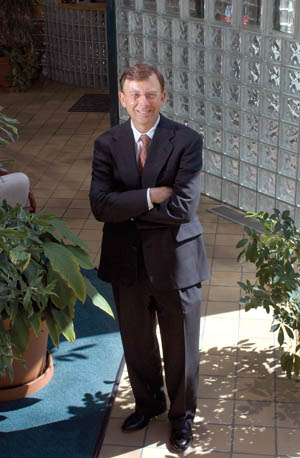
Joseph F. Morris is President/CEO of Penn-America Group, Inc., in Hatboro, Pennsylvania.
Small can be big
Penn-America's careful selection of a limited number of general agencies results in profitability
By Phil Zinkewicz
 |
Joseph F. Morris is President/CEO of Penn-America Group, Inc., in Hatboro, Pennsylvania. |
If there’s one thing that makes the Hatboro, Pennsylvania-based Penn-America Group stand out from its competitors in the specialty property and casualty insurance marketplace, it is the strategy of working with a limited number of carefully selected general agencies located in very specific areas around the country, about 65 general agencies in all.
So says Joe Morris, Penn-America’s president and CEO, who adds that working with fewer general agents than do the company’s competitors allows Penn-America to create “franchise value” with each general agency by providing relative market exclusivity and a high level of service and support. “In return,” says Morris, “we expect that our general agents will look upon us as the carrier of first choice for the types of business we write.”
Penn-America Group is licensed to do business as an admitted carrier in all but 12 states and the District of Columbia. On a nonadmitted basis, Penn-America is licensed in 49 states plus the District of Columbia. The subsidiaries through which the holding company does business are Penn-America Insurance Company, Penn-Star Insurance Company and Penn-Patriot Insurance Company.
Penn-America’s insureds are small businesses that have limited access to larger standard lines insurers and must seek insurance in the excess and surplus lines market because of their rural locations and small premium size, says Morris. “Concentrating on this secondary market allows us greater pricing flexibility as well as flexibility in excluding coverages for specific loss exposures and lower premium taxes and state guaranty fund assessments,” he says. “Small businesses in rural areas of the nation are the engine of the American economy, representing 47% of all sales in the country. It is a vital and growing market.”
Morris says that Penn-America writes a wide array of small to medium-sized commercial accounts on a binding authority basis. “We are continuously searching for products and programs that mutually benefit the company, our general agencies and the insureds,” says Morris.
Wide array of markets
Penn-America does indeed serve a wide variety of markets. It writes coverages for adult day care centers, commercial child day care centers and residential child care, restaur-ants, bars and taverns, artisans/contractors, alarm installers, contractor’s equipment, habitational exposures (apartment buildings and dwelling lessors risk only), animal care professionals, beauty and grooming professionals, and exercise and fitness professionals.
“We are very specific in our underwriting criteria,” says Morris. “In our adult day care program, for example, we look for insureds with active adults. We offer professional liability limits up to $1 million per occurrence. Property limits up to $5 million per risk are also available. Installers of security alarm systems in residences and businesses can purchase limits up to $3 million per occurrence or $3 million aggregate. New ventures are eligible. Our beauty and grooming professionals program is designed for barbers, beauty salons, cosmetologists, manicurists and beauty schools. Our builders risk program is designed for buildings in the course of construction, and commercial and residential properties are eligible.”
Getting back to Penn-America’s general agent strategy, Morris says Penn-America uses the services of two to four general agencies per state or territory. “Our competitors, who employ many more general agencies, can’t provide the services we provide to their vast producer groups. Our turnaround in terms of submissions and claims handling is better because we can focus our IT resources on fewer agents.”
Easy to work with
Bill Kiley, president of Connecticut Underwriters, one of the general agencies that works with Penn-America, supports Morris’s views on the limited general agency strategy. Kiley, whose firm has offices in New Hampshire and Massachusetts as well as Connecticut, says that Penn-America is “a very easy company to do business with.” He says, “Because Penn-America uses a limited number of general agents, we have developed a strong relationship. That relationship makes for better communication with our underwriters as well.”
Connecticut Underwriters specializes in habitational risks, restaurants, bars and taverns, and artisans and contractors, among other exposures. Kiley says that one of the benefits of working with Penn-America is that it has made a significant investment in technology as a pivotal business strategy. “They have a sophisticated Internet site called PennLINK that provides insurance forms and instant access to an agent’s entire business with Penn-America, from policies to claims systems, profitability performance, a document imaging system and online underwriting manuals. Agents can do loss runs and renewals with a great deal of ease. In terms of technology, I think Penn-America is far ahead of its competitors,” says Kiley.
Morris says that retail agents can access Penn-America through the general agents they work with. “They can come on to our Web site, where there is a map of the country provided, click on any state and find out which general agencies represent our company,” says Morris.
Because Penn-America is an excess and surplus lines market, Rough Notes asked Morris how he expects his firm to fare in the emerging soft market. Typically, during soft market periods, E&S companies lose business to standard companies that are moving back into lines of business that they have previously shunned. “Your premise is accurate,” says Morris. “In soft market cycles, standard companies do go after business that they didn’t want during a hard market. But A.M. Best recently completed a study of the E&S market that showed that, during soft market cycles, the E&S business has always continued to grow. So, while on a micro basis E&S companies do lose business, on a macro basis the E&S market doesn’t really shrink. Price levels change, of course. In 2001, 2002 and 2003, we saw double-digit rate increases in many lines. In 2004 there were single-digit increases, and this year rates will probably flatten out. But that’s one reason we write small commercial accounts. They are less likely to be affected by soft market conditions than larger accounts. We currently have an excellent by-line loss ratio. Our challenge is to keep our loss ratio low during the coming soft market. But if you look at the business we write, about 75% to 80% is in the areas of habitational exposures, contractors, restaurants, retailers and commercial buildings. Those risks tend to stay in the E&S market no matter what the industry cycle.”
 |
“Our competitors, who employ many more general agencies, can’t provide the services we provide to their vast producer groups. Our turnaround in terms of submissions and claims handling is better because we can focus our IT resources on fewer agents.” — Joe Morris |
Loss control
Will loss control help Penn-America keep its loss ratio down? Morris says yes, to a certain extent. “You have to remember that, with small commercial accounts where the premiums average about $2,000, there is not all that much money to spend on loss control. On certain types of risks, we will ask our general agents to inspect the risk to be insured. Then we will make recommendations to make certain that the exposure is up to our underwriting standards. But, for the most part, we depend upon the professionalism of our general agents. We expect them to select Penn-America to be the number one carrier in their offices for the types of business our company writes; to get the best selection of available risks and thus produce superior underwriting results; and to have loyalty and longevity. Penn-America has very low agency turnover, with average agency tenure of 10 years.
We closely monitor the quality of business we underwrite by reviewing new and renewal commercial policies on a continuous basis to ensure that our underwriting guidelines are being followed. We periodically audit each agency to determine if the underwriting guidelines are being followed in all aspects of risk selection, underwriting compliance, issuance and pricing. In addition, we provide strong incentives to produce profitable business through a commission structure, which is tied to underwriting profitability.”
In January of this year, Penn-America broadened its horizons further. It became a wholly owned subsidiary of the Cayman Islands-based United America Indemnity, Ltd., a holding company for various other insurance interests. Now, under the United America umbrella, there is Penn-America Group; United National Insurance Company in Bala Cynwyd, Pennsylvania; Penn Independent Corporation, a wholesale broker of commercial insurance for small and middle market businesses, public entities and associations in the United States; and Wind River Insurance Company in Bermuda. “United National’s insurance products complemented ours, and it was a chance for United National to branch out further into the E&S market,” says Morris. “Both United National and Penn-America operate independently. United America has products in the professional liability area that we don’t have, so now our agents who are in need of those products can access them.” *
For more information:
Penn-America Group
Web sites: www.penn-america.com www.pennlink.com